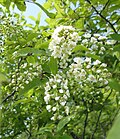Prunus virginiana
Prunus virginiana, commonly known as Chokecherry, is a species of Prunus native to North America. It is a deciduous shrub or small tree that typically grows to 4.5-7.5 meters (15-25 feet) tall. The plant is part of the Rosaceae family, which includes roses, strawberries, apples, and other fruit-bearing plants.
Description[edit]
The Prunus virginiana has a bark that is gray to reddish-brown, and its leaves are oval and finely toothed. The flowers are small, white, and typically bloom in late spring. The fruit is a small drupe that matures in late summer to early fall. The fruit is dark red to black and has a very astringent taste when raw, hence the common name "chokecherry".
Distribution and Habitat[edit]
Prunus virginiana is widely distributed across North America, from the Atlantic coast to the Pacific, and from northern Canada to Mexico. It is typically found in open woods, along roadsides, and in disturbed areas. It prefers well-drained soils and is tolerant of a wide range of soil types.
Uses[edit]
The fruit of the Prunus virginiana has been used by Native American tribes for medicinal and culinary purposes. The fruit is high in antioxidant content, particularly anthocyanins. Despite its astringent taste, it can be used to make jellies, wines, and syrups. The wood of the plant is also used for making tools and furniture.
Cultivation[edit]
Prunus virginiana is often used in landscaping for its attractive spring flowers and colorful fall foliage. It is also used in restoration and reclamation projects due to its ability to stabilize soils and provide habitat for wildlife.
Conservation Status[edit]
While Prunus virginiana is not currently listed as threatened or endangered, it is susceptible to a number of pests and diseases, including black knot, leaf spot, and powdery mildew.
See Also[edit]
-
Prunus virginiana flowers
-
Chokecherry
-
Prunus virginiana closeup
-
Chokecherry showing autumn foliage coloration
-
Chokecherries being prepared for wojapi
Ad. Transform your life with W8MD's Budget GLP-1 injections from $75


W8MD offers a medical weight loss program to lose weight in Philadelphia. Our physician-supervised medical weight loss provides:
- Weight loss injections in NYC (generic and brand names):
- Zepbound / Mounjaro, Wegovy / Ozempic, Saxenda
- Most insurances accepted or discounted self-pay rates. We will obtain insurance prior authorizations if needed.
- Generic GLP1 weight loss injections from $75 for the starting dose.
- Also offer prescription weight loss medications including Phentermine, Qsymia, Diethylpropion, Contrave etc.
NYC weight loss doctor appointmentsNYC weight loss doctor appointments
Start your NYC weight loss journey today at our NYC medical weight loss and Philadelphia medical weight loss clinics.
- Call 718-946-5500 to lose weight in NYC or for medical weight loss in Philadelphia 215-676-2334.
- Tags:NYC medical weight loss, Philadelphia lose weight Zepbound NYC, Budget GLP1 weight loss injections, Wegovy Philadelphia, Wegovy NYC, Philadelphia medical weight loss, Brookly weight loss and Wegovy NYC
|
WikiMD's Wellness Encyclopedia |
| Let Food Be Thy Medicine Medicine Thy Food - Hippocrates |
Medical Disclaimer: WikiMD is not a substitute for professional medical advice. The information on WikiMD is provided as an information resource only, may be incorrect, outdated or misleading, and is not to be used or relied on for any diagnostic or treatment purposes. Please consult your health care provider before making any healthcare decisions or for guidance about a specific medical condition. WikiMD expressly disclaims responsibility, and shall have no liability, for any damages, loss, injury, or liability whatsoever suffered as a result of your reliance on the information contained in this site. By visiting this site you agree to the foregoing terms and conditions, which may from time to time be changed or supplemented by WikiMD. If you do not agree to the foregoing terms and conditions, you should not enter or use this site. See full disclaimer.
Credits:Most images are courtesy of Wikimedia commons, and templates, categories Wikipedia, licensed under CC BY SA or similar.
Translate this page: - East Asian
中文,
日本,
한국어,
South Asian
हिन्दी,
தமிழ்,
తెలుగు,
Urdu,
ಕನ್ನಡ,
Southeast Asian
Indonesian,
Vietnamese,
Thai,
မြန်မာဘာသာ,
বাংলা
European
español,
Deutsch,
français,
Greek,
português do Brasil,
polski,
română,
русский,
Nederlands,
norsk,
svenska,
suomi,
Italian
Middle Eastern & African
عربى,
Turkish,
Persian,
Hebrew,
Afrikaans,
isiZulu,
Kiswahili,
Other
Bulgarian,
Hungarian,
Czech,
Swedish,
മലയാളം,
मराठी,
ਪੰਜਾਬੀ,
ગુજરાતી,
Portuguese,
Ukrainian





